Communication for Safety: Improving Quality and Safety in Healthcare
VerifiedAdded on 2021/06/16
|12
|3404
|89
Report
AI Summary
This report examines the vital role of communication in ensuring patient safety and quality within the Australian healthcare system, focusing on the National Safety and Quality Health Service (NSQHS) Standards. It emphasizes the interconnectedness of patient safety and quality of care, highlighting attributes such as appropriateness, effectiveness, and efficiency. The report discusses the importance of organizational culture, teamwork, and effective feedback mechanisms in promoting a safe environment. It also analyzes how ineffective communication can lead to errors, compromise patient autonomy, and damage trust, providing examples of clinical handover failures and cultural insensitivity. The report suggests strategies for evaluating communication procedures, including questionnaire surveys and documentation analysis, and proposes initiatives such as policy development and training sessions to foster effective communication and improve patient outcomes. Desklib offers a wealth of resources, including this report and other solved assignments, to support students in their studies.
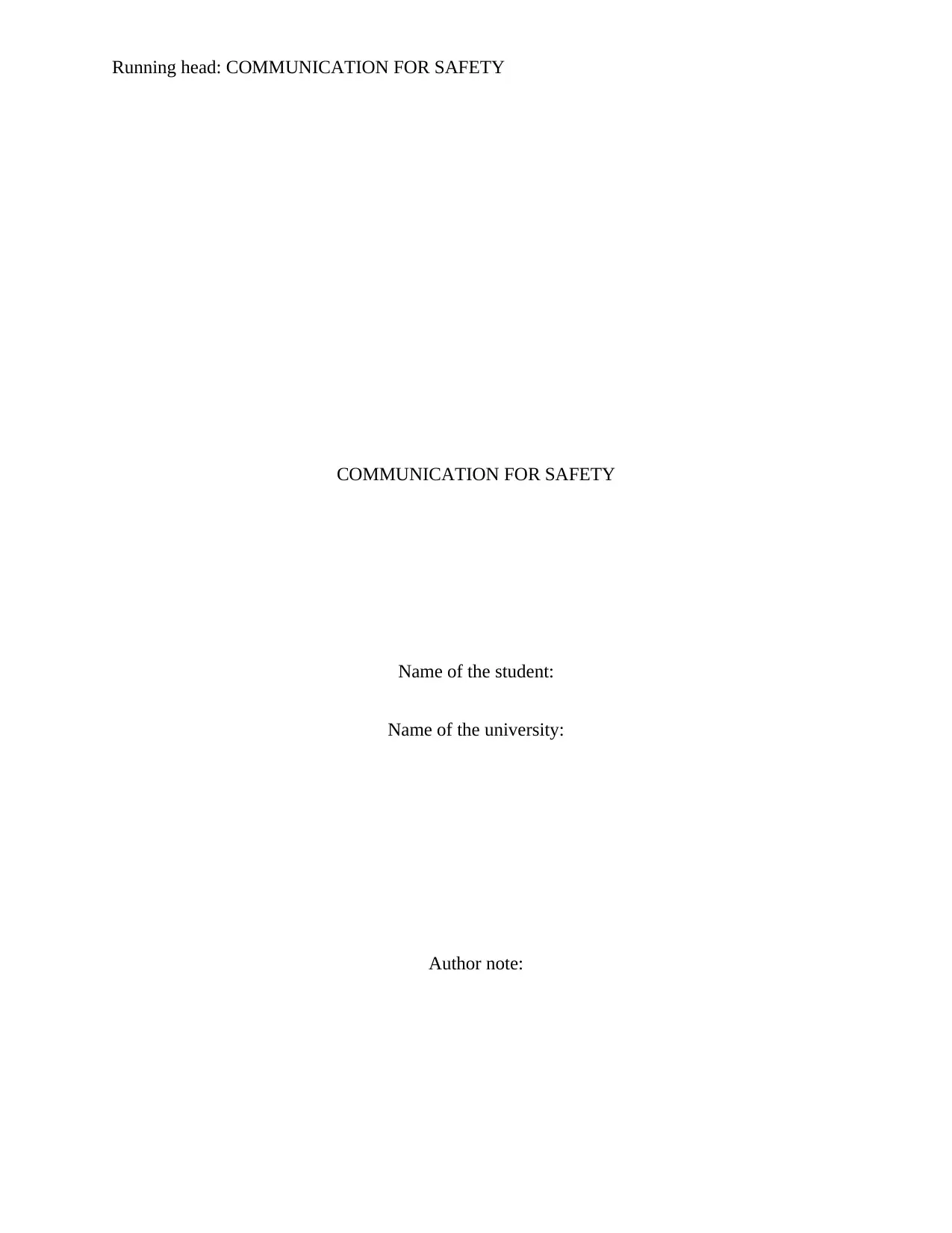
Running head: COMMUNICATION FOR SAFETY
COMMUNICATION FOR SAFETY
Name of the student:
Name of the university:
Author note:
COMMUNICATION FOR SAFETY
Name of the student:
Name of the university:
Author note:
Paraphrase This Document
Need a fresh take? Get an instant paraphrase of this document with our AI Paraphraser
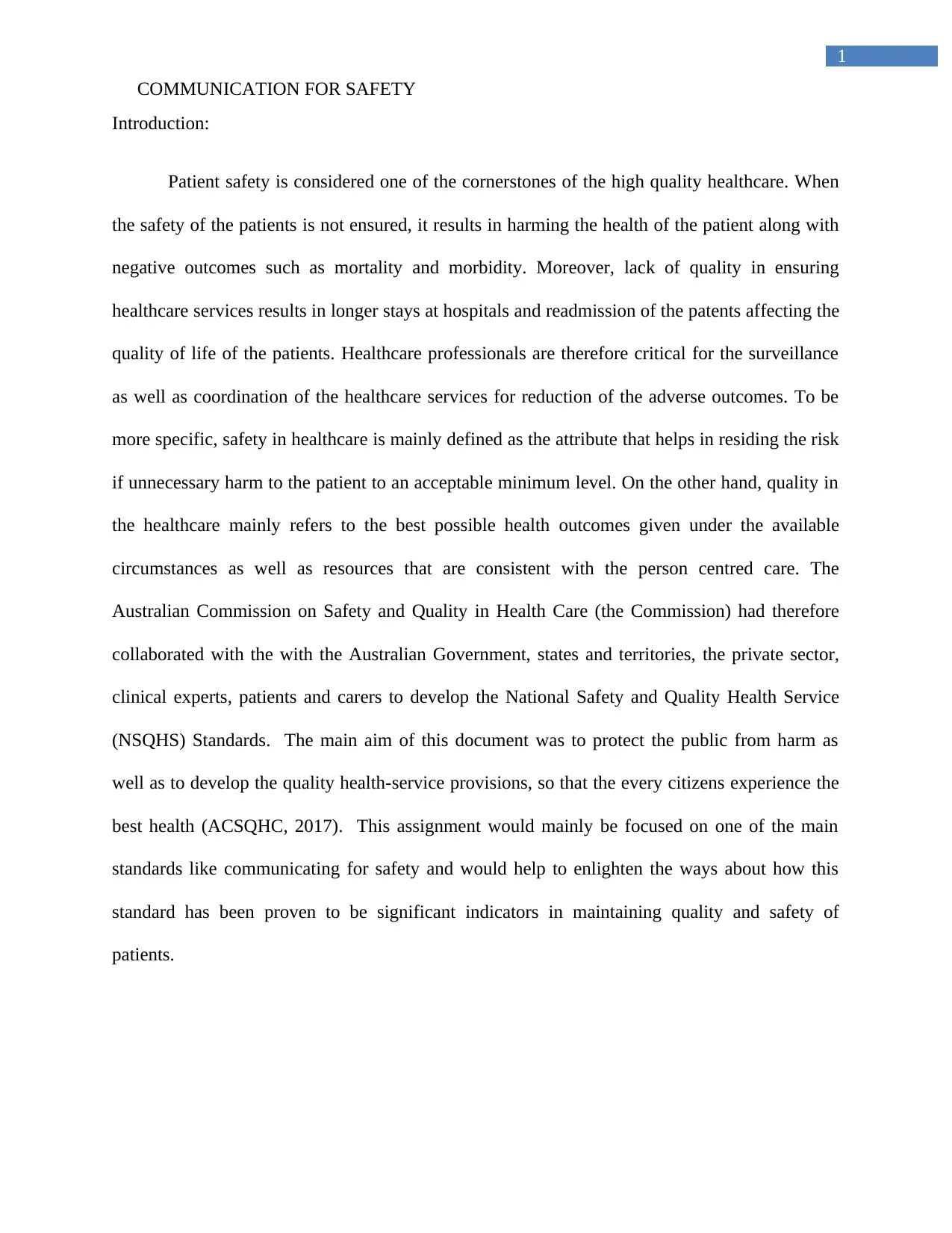
1
COMMUNICATION FOR SAFETY
Introduction:
Patient safety is considered one of the cornerstones of the high quality healthcare. When
the safety of the patients is not ensured, it results in harming the health of the patient along with
negative outcomes such as mortality and morbidity. Moreover, lack of quality in ensuring
healthcare services results in longer stays at hospitals and readmission of the patents affecting the
quality of life of the patients. Healthcare professionals are therefore critical for the surveillance
as well as coordination of the healthcare services for reduction of the adverse outcomes. To be
more specific, safety in healthcare is mainly defined as the attribute that helps in residing the risk
if unnecessary harm to the patient to an acceptable minimum level. On the other hand, quality in
the healthcare mainly refers to the best possible health outcomes given under the available
circumstances as well as resources that are consistent with the person centred care. The
Australian Commission on Safety and Quality in Health Care (the Commission) had therefore
collaborated with the with the Australian Government, states and territories, the private sector,
clinical experts, patients and carers to develop the National Safety and Quality Health Service
(NSQHS) Standards. The main aim of this document was to protect the public from harm as
well as to develop the quality health-service provisions, so that the every citizens experience the
best health (ACSQHC, 2017). This assignment would mainly be focused on one of the main
standards like communicating for safety and would help to enlighten the ways about how this
standard has been proven to be significant indicators in maintaining quality and safety of
patients.
COMMUNICATION FOR SAFETY
Introduction:
Patient safety is considered one of the cornerstones of the high quality healthcare. When
the safety of the patients is not ensured, it results in harming the health of the patient along with
negative outcomes such as mortality and morbidity. Moreover, lack of quality in ensuring
healthcare services results in longer stays at hospitals and readmission of the patents affecting the
quality of life of the patients. Healthcare professionals are therefore critical for the surveillance
as well as coordination of the healthcare services for reduction of the adverse outcomes. To be
more specific, safety in healthcare is mainly defined as the attribute that helps in residing the risk
if unnecessary harm to the patient to an acceptable minimum level. On the other hand, quality in
the healthcare mainly refers to the best possible health outcomes given under the available
circumstances as well as resources that are consistent with the person centred care. The
Australian Commission on Safety and Quality in Health Care (the Commission) had therefore
collaborated with the with the Australian Government, states and territories, the private sector,
clinical experts, patients and carers to develop the National Safety and Quality Health Service
(NSQHS) Standards. The main aim of this document was to protect the public from harm as
well as to develop the quality health-service provisions, so that the every citizens experience the
best health (ACSQHC, 2017). This assignment would mainly be focused on one of the main
standards like communicating for safety and would help to enlighten the ways about how this
standard has been proven to be significant indicators in maintaining quality and safety of
patients.
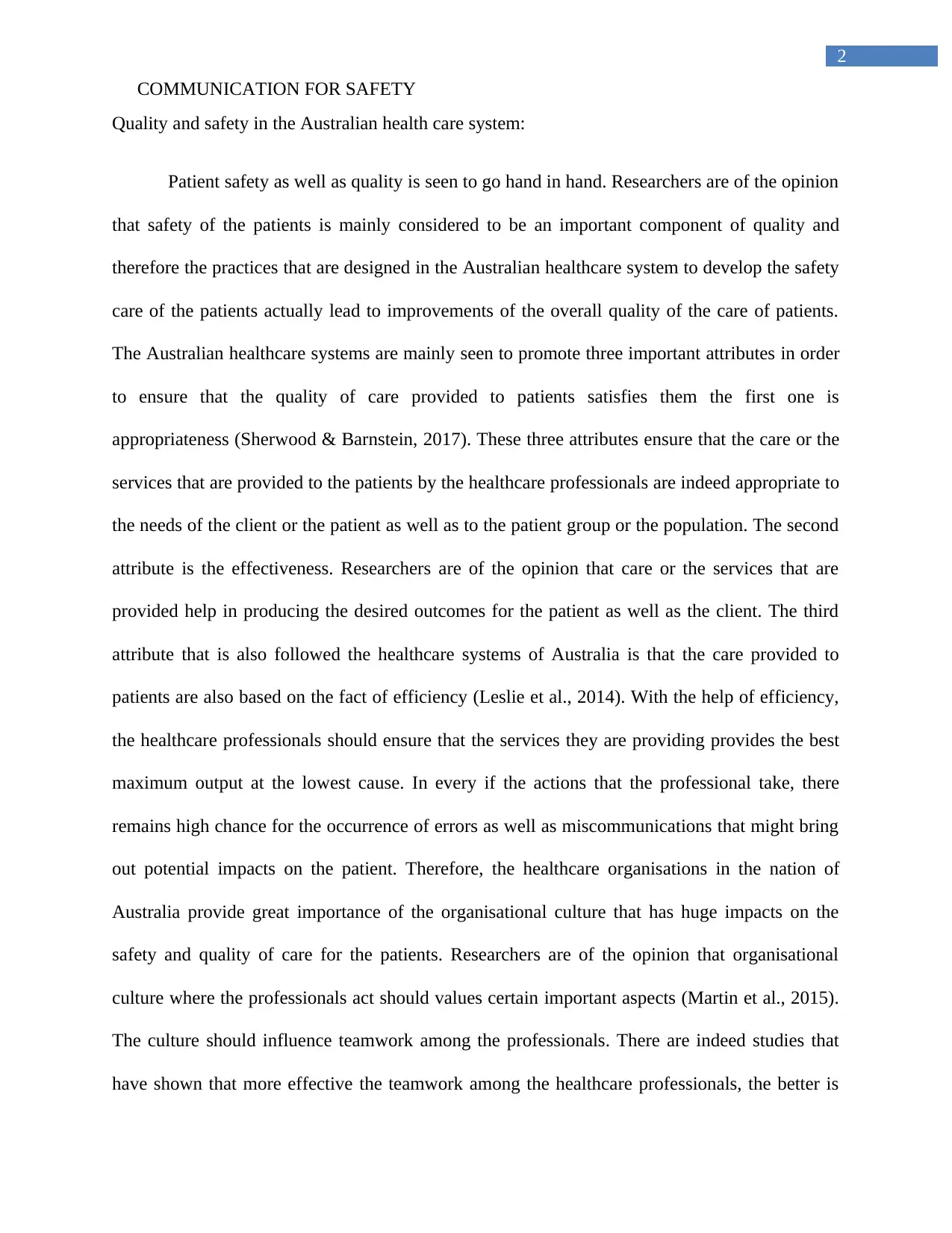
2
COMMUNICATION FOR SAFETY
Quality and safety in the Australian health care system:
Patient safety as well as quality is seen to go hand in hand. Researchers are of the opinion
that safety of the patients is mainly considered to be an important component of quality and
therefore the practices that are designed in the Australian healthcare system to develop the safety
care of the patients actually lead to improvements of the overall quality of the care of patients.
The Australian healthcare systems are mainly seen to promote three important attributes in order
to ensure that the quality of care provided to patients satisfies them the first one is
appropriateness (Sherwood & Barnstein, 2017). These three attributes ensure that the care or the
services that are provided to the patients by the healthcare professionals are indeed appropriate to
the needs of the client or the patient as well as to the patient group or the population. The second
attribute is the effectiveness. Researchers are of the opinion that care or the services that are
provided help in producing the desired outcomes for the patient as well as the client. The third
attribute that is also followed the healthcare systems of Australia is that the care provided to
patients are also based on the fact of efficiency (Leslie et al., 2014). With the help of efficiency,
the healthcare professionals should ensure that the services they are providing provides the best
maximum output at the lowest cause. In every if the actions that the professional take, there
remains high chance for the occurrence of errors as well as miscommunications that might bring
out potential impacts on the patient. Therefore, the healthcare organisations in the nation of
Australia provide great importance of the organisational culture that has huge impacts on the
safety and quality of care for the patients. Researchers are of the opinion that organisational
culture where the professionals act should values certain important aspects (Martin et al., 2015).
The culture should influence teamwork among the professionals. There are indeed studies that
have shown that more effective the teamwork among the healthcare professionals, the better is
COMMUNICATION FOR SAFETY
Quality and safety in the Australian health care system:
Patient safety as well as quality is seen to go hand in hand. Researchers are of the opinion
that safety of the patients is mainly considered to be an important component of quality and
therefore the practices that are designed in the Australian healthcare system to develop the safety
care of the patients actually lead to improvements of the overall quality of the care of patients.
The Australian healthcare systems are mainly seen to promote three important attributes in order
to ensure that the quality of care provided to patients satisfies them the first one is
appropriateness (Sherwood & Barnstein, 2017). These three attributes ensure that the care or the
services that are provided to the patients by the healthcare professionals are indeed appropriate to
the needs of the client or the patient as well as to the patient group or the population. The second
attribute is the effectiveness. Researchers are of the opinion that care or the services that are
provided help in producing the desired outcomes for the patient as well as the client. The third
attribute that is also followed the healthcare systems of Australia is that the care provided to
patients are also based on the fact of efficiency (Leslie et al., 2014). With the help of efficiency,
the healthcare professionals should ensure that the services they are providing provides the best
maximum output at the lowest cause. In every if the actions that the professional take, there
remains high chance for the occurrence of errors as well as miscommunications that might bring
out potential impacts on the patient. Therefore, the healthcare organisations in the nation of
Australia provide great importance of the organisational culture that has huge impacts on the
safety and quality of care for the patients. Researchers are of the opinion that organisational
culture where the professionals act should values certain important aspects (Martin et al., 2015).
The culture should influence teamwork among the professionals. There are indeed studies that
have shown that more effective the teamwork among the healthcare professionals, the better is
⊘ This is a preview!⊘
Do you want full access?
Subscribe today to unlock all pages.

Trusted by 1+ million students worldwide

3
COMMUNICATION FOR SAFETY
the quality of care provided to the patients and safer the patients feel. Better, the teamwork better
would be the bonding and reliance of the professionals on each other and this would result in the
reduction in power struggles and ego clashes. This human factor would thereby ensure effective
communication among the members that would reduce errors in the care provided and increase
safety. Moreover, an environment within the organisation of Australia promotes effective
feedback from the professionals as well as speaking up that in turn encourages reporting of
unprofessional practices, medication errors, lack of resources, improper documentation, lack of
knowledge and education, requirement of training and many others (Carayon et al., 2014). All
these ensure that the expertise that the healthcare professionals would develop would ensure not
only quality but also safety of the patients. In order to ensure maintenance of safety as well as
quality of the patients, the National Safety and Quality Health Service (NSQHS) Standards had
been proposed that had identified eight important standards for the ensuring of the safety of
patients and developing the quality of the care provided to patients (Ruciman, Merry & Walton,
2017). These are the clinical governance, collaborating with the consumers, prevention and
controlling of the healthcare associated infection and medication safety. It also involves
comprehensive care, communicating for safety, blood management, recognising, and responding
to acute deterioration.
Clinical care activity:
Communication is one of the most important aspect of safe healthcare and this had been
supported by many researchers over time. Ineffective communication has the capacity to affect
safe delivery of healthcare by making different types of errors such as during the time of
delegation. While delegating task properly to a fellow healthcare professionals, it is expected of
the professional to provide detailed information in a documented as well as verbal ways (Arnold
COMMUNICATION FOR SAFETY
the quality of care provided to the patients and safer the patients feel. Better, the teamwork better
would be the bonding and reliance of the professionals on each other and this would result in the
reduction in power struggles and ego clashes. This human factor would thereby ensure effective
communication among the members that would reduce errors in the care provided and increase
safety. Moreover, an environment within the organisation of Australia promotes effective
feedback from the professionals as well as speaking up that in turn encourages reporting of
unprofessional practices, medication errors, lack of resources, improper documentation, lack of
knowledge and education, requirement of training and many others (Carayon et al., 2014). All
these ensure that the expertise that the healthcare professionals would develop would ensure not
only quality but also safety of the patients. In order to ensure maintenance of safety as well as
quality of the patients, the National Safety and Quality Health Service (NSQHS) Standards had
been proposed that had identified eight important standards for the ensuring of the safety of
patients and developing the quality of the care provided to patients (Ruciman, Merry & Walton,
2017). These are the clinical governance, collaborating with the consumers, prevention and
controlling of the healthcare associated infection and medication safety. It also involves
comprehensive care, communicating for safety, blood management, recognising, and responding
to acute deterioration.
Clinical care activity:
Communication is one of the most important aspect of safe healthcare and this had been
supported by many researchers over time. Ineffective communication has the capacity to affect
safe delivery of healthcare by making different types of errors such as during the time of
delegation. While delegating task properly to a fellow healthcare professionals, it is expected of
the professional to provide detailed information in a documented as well as verbal ways (Arnold
Paraphrase This Document
Need a fresh take? Get an instant paraphrase of this document with our AI Paraphraser

4
COMMUNICATION FOR SAFETY
et al., 2015). Infective listening, fast speaking, fidgety body language and many others have the
capability to miss out information and this missing of information may result in potential wrong
treatment of improper care delivery that may affect the safety of the patient. Proper medical
backgrounds, present condition of the patients, observation of the nurses, proper medication plan
and care plan of the professionals should be communicated in details so that the service provided
to patients is not only of high quality but also of higher safety. Effective communication among
the team members have the capability to develop transparency among the professionals where
they tend to put the safety of the patients as their priority and effectively engage themselves
information sharing about the health of the patient as well as the discuss the risk factors
associated with the health of patients (Gausvik et al., 2015). This would be mainly helping in the
effective sharing of information and thereby the professional gathering complete knowledge
about the health of the patient and them planning their own approach to treat the patient. The
organisations should take up initiatives by which they can ensure that communication among the
inter as well as intradepartmental members would help to develop a working climate where the
safety of the patients would be provided the highest quality and initiatives for maintaining the
quality of care through effective communication (Johnston et al., 2015). Effective
communication is indeed helpful in maintaining safety of the patients as it helps in the flow of
information among the members that might have important impact on the health of the person
both physically as well as mentally. This could be explained with the help of information. Often
it is seen that clinical handover may incorporate important information like the symptoms of
patients, conditions of patients, vital signs, deteriorating as well as developing health of patients
and many others. Therefore, when one professional does not do documentation properly, the
information may not be well communicated to the other professional who may come in the next
COMMUNICATION FOR SAFETY
et al., 2015). Infective listening, fast speaking, fidgety body language and many others have the
capability to miss out information and this missing of information may result in potential wrong
treatment of improper care delivery that may affect the safety of the patient. Proper medical
backgrounds, present condition of the patients, observation of the nurses, proper medication plan
and care plan of the professionals should be communicated in details so that the service provided
to patients is not only of high quality but also of higher safety. Effective communication among
the team members have the capability to develop transparency among the professionals where
they tend to put the safety of the patients as their priority and effectively engage themselves
information sharing about the health of the patient as well as the discuss the risk factors
associated with the health of patients (Gausvik et al., 2015). This would be mainly helping in the
effective sharing of information and thereby the professional gathering complete knowledge
about the health of the patient and them planning their own approach to treat the patient. The
organisations should take up initiatives by which they can ensure that communication among the
inter as well as intradepartmental members would help to develop a working climate where the
safety of the patients would be provided the highest quality and initiatives for maintaining the
quality of care through effective communication (Johnston et al., 2015). Effective
communication is indeed helpful in maintaining safety of the patients as it helps in the flow of
information among the members that might have important impact on the health of the person
both physically as well as mentally. This could be explained with the help of information. Often
it is seen that clinical handover may incorporate important information like the symptoms of
patients, conditions of patients, vital signs, deteriorating as well as developing health of patients
and many others. Therefore, when one professional does not do documentation properly, the
information may not be well communicated to the other professional who may come in the next
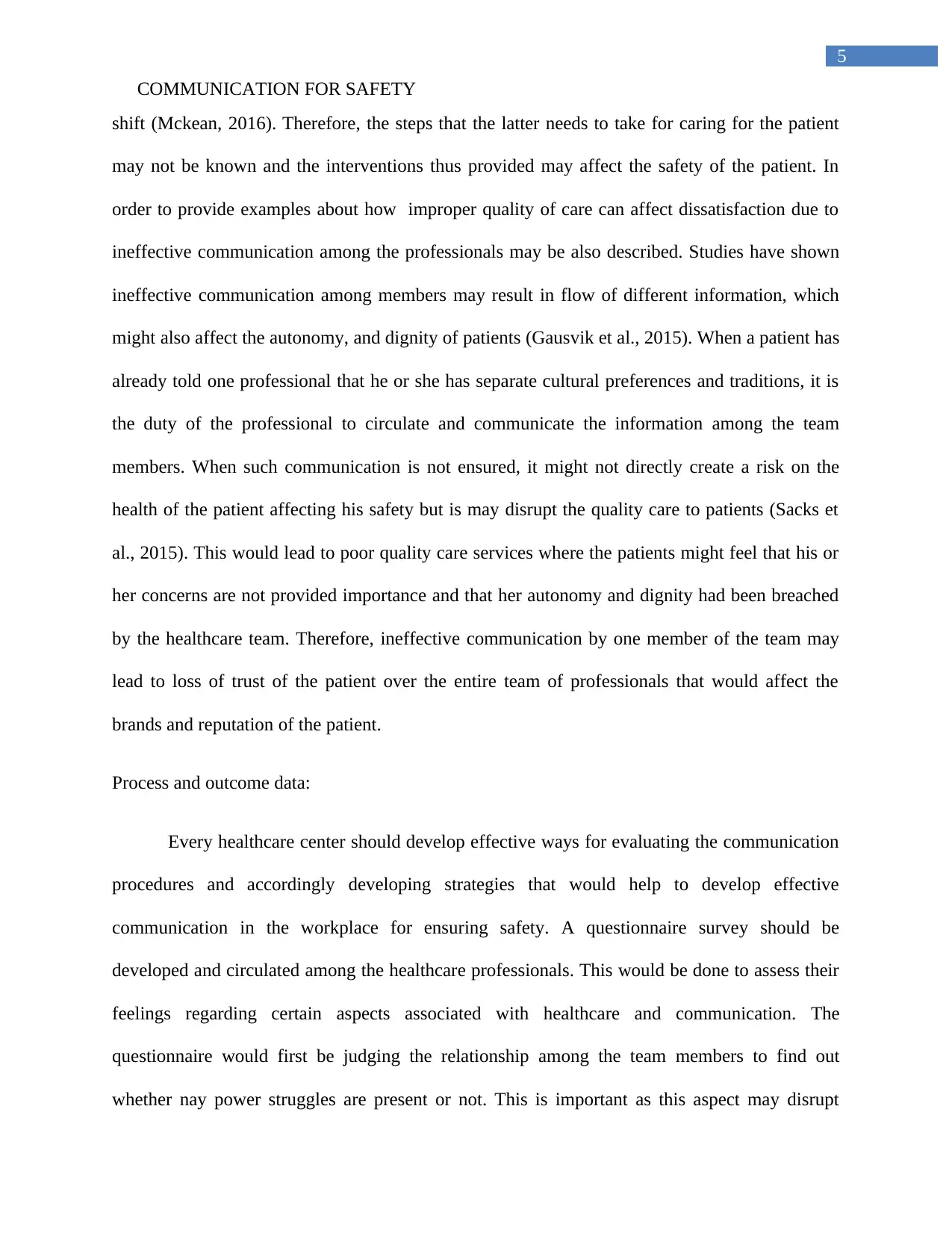
5
COMMUNICATION FOR SAFETY
shift (Mckean, 2016). Therefore, the steps that the latter needs to take for caring for the patient
may not be known and the interventions thus provided may affect the safety of the patient. In
order to provide examples about how improper quality of care can affect dissatisfaction due to
ineffective communication among the professionals may be also described. Studies have shown
ineffective communication among members may result in flow of different information, which
might also affect the autonomy, and dignity of patients (Gausvik et al., 2015). When a patient has
already told one professional that he or she has separate cultural preferences and traditions, it is
the duty of the professional to circulate and communicate the information among the team
members. When such communication is not ensured, it might not directly create a risk on the
health of the patient affecting his safety but is may disrupt the quality care to patients (Sacks et
al., 2015). This would lead to poor quality care services where the patients might feel that his or
her concerns are not provided importance and that her autonomy and dignity had been breached
by the healthcare team. Therefore, ineffective communication by one member of the team may
lead to loss of trust of the patient over the entire team of professionals that would affect the
brands and reputation of the patient.
Process and outcome data:
Every healthcare center should develop effective ways for evaluating the communication
procedures and accordingly developing strategies that would help to develop effective
communication in the workplace for ensuring safety. A questionnaire survey should be
developed and circulated among the healthcare professionals. This would be done to assess their
feelings regarding certain aspects associated with healthcare and communication. The
questionnaire would first be judging the relationship among the team members to find out
whether nay power struggles are present or not. This is important as this aspect may disrupt
COMMUNICATION FOR SAFETY
shift (Mckean, 2016). Therefore, the steps that the latter needs to take for caring for the patient
may not be known and the interventions thus provided may affect the safety of the patient. In
order to provide examples about how improper quality of care can affect dissatisfaction due to
ineffective communication among the professionals may be also described. Studies have shown
ineffective communication among members may result in flow of different information, which
might also affect the autonomy, and dignity of patients (Gausvik et al., 2015). When a patient has
already told one professional that he or she has separate cultural preferences and traditions, it is
the duty of the professional to circulate and communicate the information among the team
members. When such communication is not ensured, it might not directly create a risk on the
health of the patient affecting his safety but is may disrupt the quality care to patients (Sacks et
al., 2015). This would lead to poor quality care services where the patients might feel that his or
her concerns are not provided importance and that her autonomy and dignity had been breached
by the healthcare team. Therefore, ineffective communication by one member of the team may
lead to loss of trust of the patient over the entire team of professionals that would affect the
brands and reputation of the patient.
Process and outcome data:
Every healthcare center should develop effective ways for evaluating the communication
procedures and accordingly developing strategies that would help to develop effective
communication in the workplace for ensuring safety. A questionnaire survey should be
developed and circulated among the healthcare professionals. This would be done to assess their
feelings regarding certain aspects associated with healthcare and communication. The
questionnaire would first be judging the relationship among the team members to find out
whether nay power struggles are present or not. This is important as this aspect may disrupt
⊘ This is a preview!⊘
Do you want full access?
Subscribe today to unlock all pages.

Trusted by 1+ million students worldwide

6
COMMUNICATION FOR SAFETY
smooth communication among the members that might result in increasing the risk of the health
of the patient impairing safety. This questionnaire would be such that it would help to understand
the transparency maintained in the organizational culture as well as in the feedback receiving and
giving of the professionals. The results obtained in each if the category can easily show whether
effective communication can be ensured or not in the organization. Another important evaluation
that should be conducted is the analysis of the documentation procedure (Gausvik et al., 2015). It
has to be taken care of that whether the nursing professionals are following proper methods to fill
up the documents about the information of the patients. It has to be seen that whether they are
filling the documents carefully or are not aware of the importance of the proper filling of the
information. The better the skills of documentation of the information, there would be less
chances of ineffective communication and there would be better safety and quality of care to the
patients. Another very important aspect is the organizational culture. It is very important of every
organization to ensure that the culture that they are maintaining in their organization is open and
in turn influences effective communication. The evaluation would also be done on the strategies
that the organization had taken up to ensure effective communication among the members as
well as between the higher authorities and the working processionals (Carayon et al., 2014). The
organization would ensure an environment where professionals should be able to provide
effective feedbacks to each other’s, do not develop work burden, develop clarity in their job role,
understand the importance of effective communication and thereby ensure that quality and safe
care are provided to patients. Evaluation committee would be set for every organizations where
they would be mainly conducting surveys, take up observational studies about the attitudes and
behaviors of the professional about effective communication on safety and many others
(Ruciman, Merry & Walton, 2017). Following these evaluation, the healthcare authorities and
COMMUNICATION FOR SAFETY
smooth communication among the members that might result in increasing the risk of the health
of the patient impairing safety. This questionnaire would be such that it would help to understand
the transparency maintained in the organizational culture as well as in the feedback receiving and
giving of the professionals. The results obtained in each if the category can easily show whether
effective communication can be ensured or not in the organization. Another important evaluation
that should be conducted is the analysis of the documentation procedure (Gausvik et al., 2015). It
has to be taken care of that whether the nursing professionals are following proper methods to fill
up the documents about the information of the patients. It has to be seen that whether they are
filling the documents carefully or are not aware of the importance of the proper filling of the
information. The better the skills of documentation of the information, there would be less
chances of ineffective communication and there would be better safety and quality of care to the
patients. Another very important aspect is the organizational culture. It is very important of every
organization to ensure that the culture that they are maintaining in their organization is open and
in turn influences effective communication. The evaluation would also be done on the strategies
that the organization had taken up to ensure effective communication among the members as
well as between the higher authorities and the working processionals (Carayon et al., 2014). The
organization would ensure an environment where professionals should be able to provide
effective feedbacks to each other’s, do not develop work burden, develop clarity in their job role,
understand the importance of effective communication and thereby ensure that quality and safe
care are provided to patients. Evaluation committee would be set for every organizations where
they would be mainly conducting surveys, take up observational studies about the attitudes and
behaviors of the professional about effective communication on safety and many others
(Ruciman, Merry & Walton, 2017). Following these evaluation, the healthcare authorities and
Paraphrase This Document
Need a fresh take? Get an instant paraphrase of this document with our AI Paraphraser

7
COMMUNICATION FOR SAFETY
the evaluation committee can put forward a number of initiatives. Depending upon the result,
policies could be established with the help of policy makers where effective communication
strategies for maintaining safety and quality of care can be proposed. The professionals can
follow these and thereby develop the care they provide. Moreover, training sessions and
workshops can be also established that will in turn ensure that the professionals are
understanding the importance of communication among team members, clinical handover and
documentation techniques. The better they develop ideas and are trained, the better they will be
able to maintain safety and quality in organizations.
Conclusion:
From the entire discussion above, it is seen that quality and safety of the patients are two
interconnected aspects of healthcare delivery in the healthcare industry of the nation of Australia.
Every patients have the human rights to get effective service delivery from the healthcare
professionals that would not only satisfy them through the quality but would also prevent them
from any potential negative effects through proper safe practices. The National Health and Safety
standards have provided delight important arenas that ensure proper maintenance of safety and
quality in healthcare centers. One of the most important ways is to ensure effective
communication in healthcare that would ensure safety of patients. Proper evaluation and
implementation strategies should be taken up by the authorities so that safety and quality is
ensured by organization,. These would help the citizens to live high quality life.
COMMUNICATION FOR SAFETY
the evaluation committee can put forward a number of initiatives. Depending upon the result,
policies could be established with the help of policy makers where effective communication
strategies for maintaining safety and quality of care can be proposed. The professionals can
follow these and thereby develop the care they provide. Moreover, training sessions and
workshops can be also established that will in turn ensure that the professionals are
understanding the importance of communication among team members, clinical handover and
documentation techniques. The better they develop ideas and are trained, the better they will be
able to maintain safety and quality in organizations.
Conclusion:
From the entire discussion above, it is seen that quality and safety of the patients are two
interconnected aspects of healthcare delivery in the healthcare industry of the nation of Australia.
Every patients have the human rights to get effective service delivery from the healthcare
professionals that would not only satisfy them through the quality but would also prevent them
from any potential negative effects through proper safe practices. The National Health and Safety
standards have provided delight important arenas that ensure proper maintenance of safety and
quality in healthcare centers. One of the most important ways is to ensure effective
communication in healthcare that would ensure safety of patients. Proper evaluation and
implementation strategies should be taken up by the authorities so that safety and quality is
ensured by organization,. These would help the citizens to live high quality life.
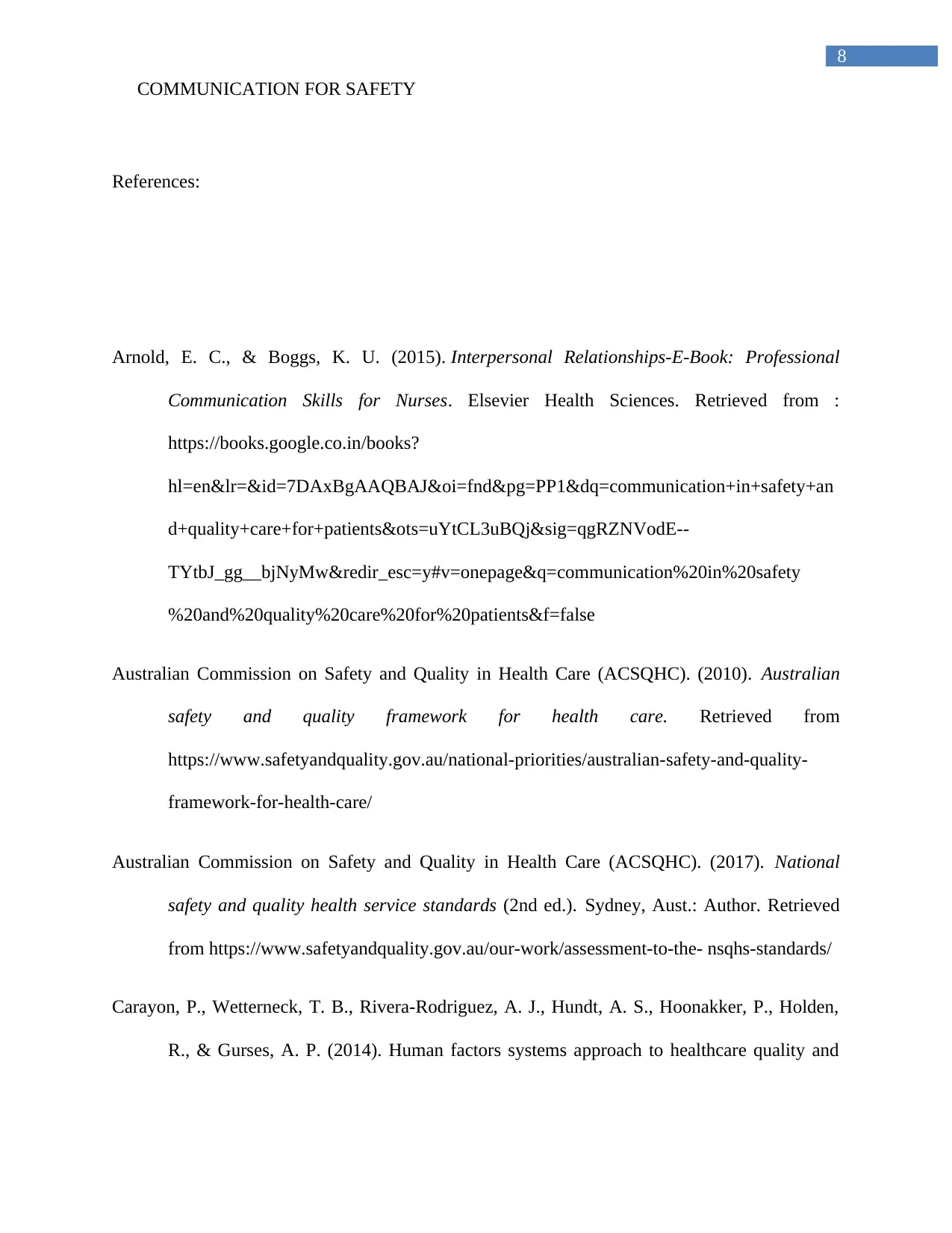
8
COMMUNICATION FOR SAFETY
References:
Arnold, E. C., & Boggs, K. U. (2015). Interpersonal Relationships-E-Book: Professional
Communication Skills for Nurses. Elsevier Health Sciences. Retrieved from :
https://books.google.co.in/books?
hl=en&lr=&id=7DAxBgAAQBAJ&oi=fnd&pg=PP1&dq=communication+in+safety+an
d+quality+care+for+patients&ots=uYtCL3uBQj&sig=qgRZNVodE--
TYtbJ_gg__bjNyMw&redir_esc=y#v=onepage&q=communication%20in%20safety
%20and%20quality%20care%20for%20patients&f=false
Australian Commission on Safety and Quality in Health Care (ACSQHC). (2010). Australian
safety and quality framework for health care. Retrieved from
https://www.safetyandquality.gov.au/national-priorities/australian-safety-and-quality-
framework-for-health-care/
Australian Commission on Safety and Quality in Health Care (ACSQHC). (2017). National
safety and quality health service standards (2nd ed.). Sydney, Aust.: Author. Retrieved
from https://www.safetyandquality.gov.au/our-work/assessment-to-the- nsqhs-standards/
Carayon, P., Wetterneck, T. B., Rivera-Rodriguez, A. J., Hundt, A. S., Hoonakker, P., Holden,
R., & Gurses, A. P. (2014). Human factors systems approach to healthcare quality and
COMMUNICATION FOR SAFETY
References:
Arnold, E. C., & Boggs, K. U. (2015). Interpersonal Relationships-E-Book: Professional
Communication Skills for Nurses. Elsevier Health Sciences. Retrieved from :
https://books.google.co.in/books?
hl=en&lr=&id=7DAxBgAAQBAJ&oi=fnd&pg=PP1&dq=communication+in+safety+an
d+quality+care+for+patients&ots=uYtCL3uBQj&sig=qgRZNVodE--
TYtbJ_gg__bjNyMw&redir_esc=y#v=onepage&q=communication%20in%20safety
%20and%20quality%20care%20for%20patients&f=false
Australian Commission on Safety and Quality in Health Care (ACSQHC). (2010). Australian
safety and quality framework for health care. Retrieved from
https://www.safetyandquality.gov.au/national-priorities/australian-safety-and-quality-
framework-for-health-care/
Australian Commission on Safety and Quality in Health Care (ACSQHC). (2017). National
safety and quality health service standards (2nd ed.). Sydney, Aust.: Author. Retrieved
from https://www.safetyandquality.gov.au/our-work/assessment-to-the- nsqhs-standards/
Carayon, P., Wetterneck, T. B., Rivera-Rodriguez, A. J., Hundt, A. S., Hoonakker, P., Holden,
R., & Gurses, A. P. (2014). Human factors systems approach to healthcare quality and
⊘ This is a preview!⊘
Do you want full access?
Subscribe today to unlock all pages.

Trusted by 1+ million students worldwide
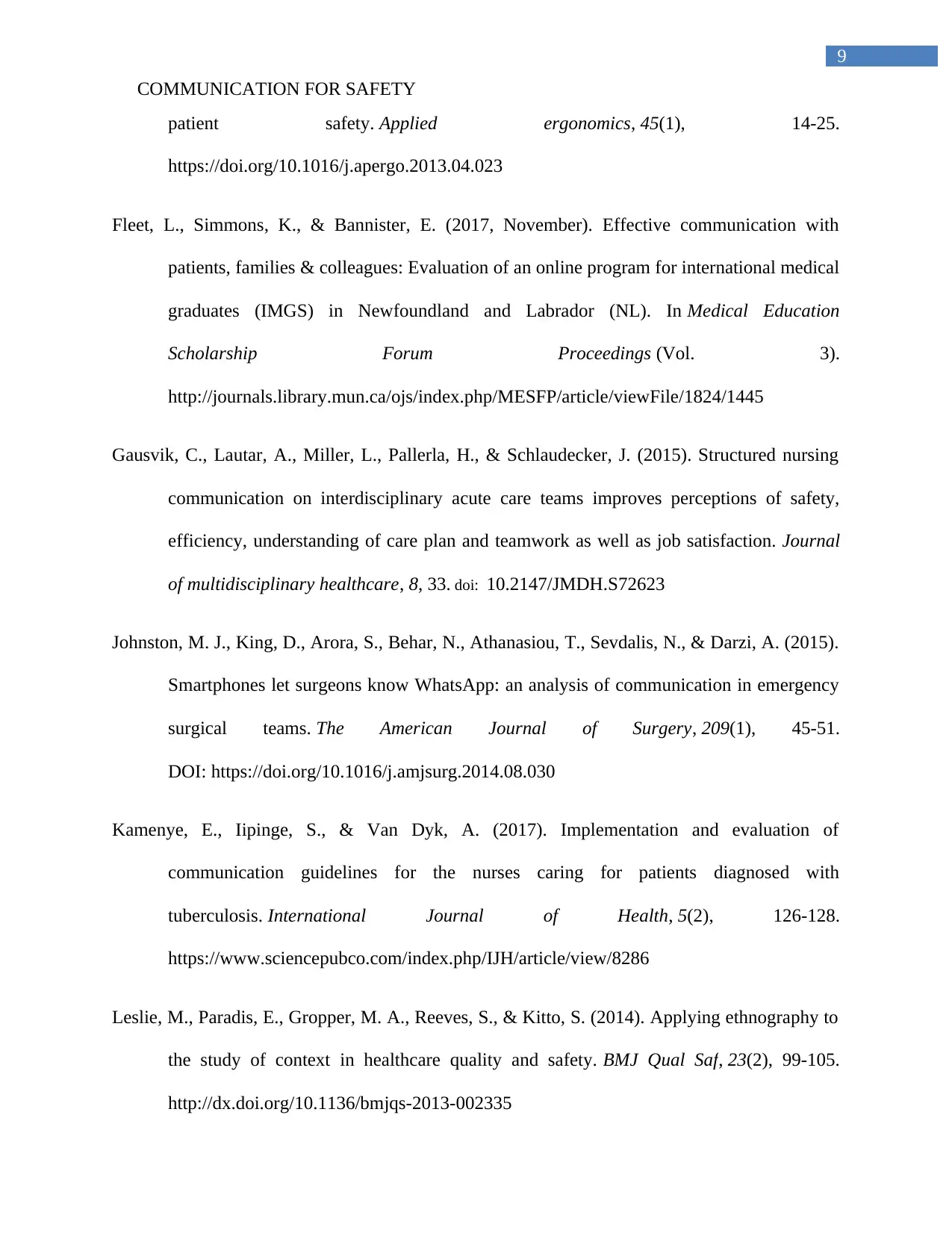
9
COMMUNICATION FOR SAFETY
patient safety. Applied ergonomics, 45(1), 14-25.
https://doi.org/10.1016/j.apergo.2013.04.023
Fleet, L., Simmons, K., & Bannister, E. (2017, November). Effective communication with
patients, families & colleagues: Evaluation of an online program for international medical
graduates (IMGS) in Newfoundland and Labrador (NL). In Medical Education
Scholarship Forum Proceedings (Vol. 3).
http://journals.library.mun.ca/ojs/index.php/MESFP/article/viewFile/1824/1445
Gausvik, C., Lautar, A., Miller, L., Pallerla, H., & Schlaudecker, J. (2015). Structured nursing
communication on interdisciplinary acute care teams improves perceptions of safety,
efficiency, understanding of care plan and teamwork as well as job satisfaction. Journal
of multidisciplinary healthcare, 8, 33. doi: 10.2147/JMDH.S72623
Johnston, M. J., King, D., Arora, S., Behar, N., Athanasiou, T., Sevdalis, N., & Darzi, A. (2015).
Smartphones let surgeons know WhatsApp: an analysis of communication in emergency
surgical teams. The American Journal of Surgery, 209(1), 45-51.
DOI: https://doi.org/10.1016/j.amjsurg.2014.08.030
Kamenye, E., Iipinge, S., & Van Dyk, A. (2017). Implementation and evaluation of
communication guidelines for the nurses caring for patients diagnosed with
tuberculosis. International Journal of Health, 5(2), 126-128.
https://www.sciencepubco.com/index.php/IJH/article/view/8286
Leslie, M., Paradis, E., Gropper, M. A., Reeves, S., & Kitto, S. (2014). Applying ethnography to
the study of context in healthcare quality and safety. BMJ Qual Saf, 23(2), 99-105.
http://dx.doi.org/10.1136/bmjqs-2013-002335
COMMUNICATION FOR SAFETY
patient safety. Applied ergonomics, 45(1), 14-25.
https://doi.org/10.1016/j.apergo.2013.04.023
Fleet, L., Simmons, K., & Bannister, E. (2017, November). Effective communication with
patients, families & colleagues: Evaluation of an online program for international medical
graduates (IMGS) in Newfoundland and Labrador (NL). In Medical Education
Scholarship Forum Proceedings (Vol. 3).
http://journals.library.mun.ca/ojs/index.php/MESFP/article/viewFile/1824/1445
Gausvik, C., Lautar, A., Miller, L., Pallerla, H., & Schlaudecker, J. (2015). Structured nursing
communication on interdisciplinary acute care teams improves perceptions of safety,
efficiency, understanding of care plan and teamwork as well as job satisfaction. Journal
of multidisciplinary healthcare, 8, 33. doi: 10.2147/JMDH.S72623
Johnston, M. J., King, D., Arora, S., Behar, N., Athanasiou, T., Sevdalis, N., & Darzi, A. (2015).
Smartphones let surgeons know WhatsApp: an analysis of communication in emergency
surgical teams. The American Journal of Surgery, 209(1), 45-51.
DOI: https://doi.org/10.1016/j.amjsurg.2014.08.030
Kamenye, E., Iipinge, S., & Van Dyk, A. (2017). Implementation and evaluation of
communication guidelines for the nurses caring for patients diagnosed with
tuberculosis. International Journal of Health, 5(2), 126-128.
https://www.sciencepubco.com/index.php/IJH/article/view/8286
Leslie, M., Paradis, E., Gropper, M. A., Reeves, S., & Kitto, S. (2014). Applying ethnography to
the study of context in healthcare quality and safety. BMJ Qual Saf, 23(2), 99-105.
http://dx.doi.org/10.1136/bmjqs-2013-002335
Paraphrase This Document
Need a fresh take? Get an instant paraphrase of this document with our AI Paraphraser
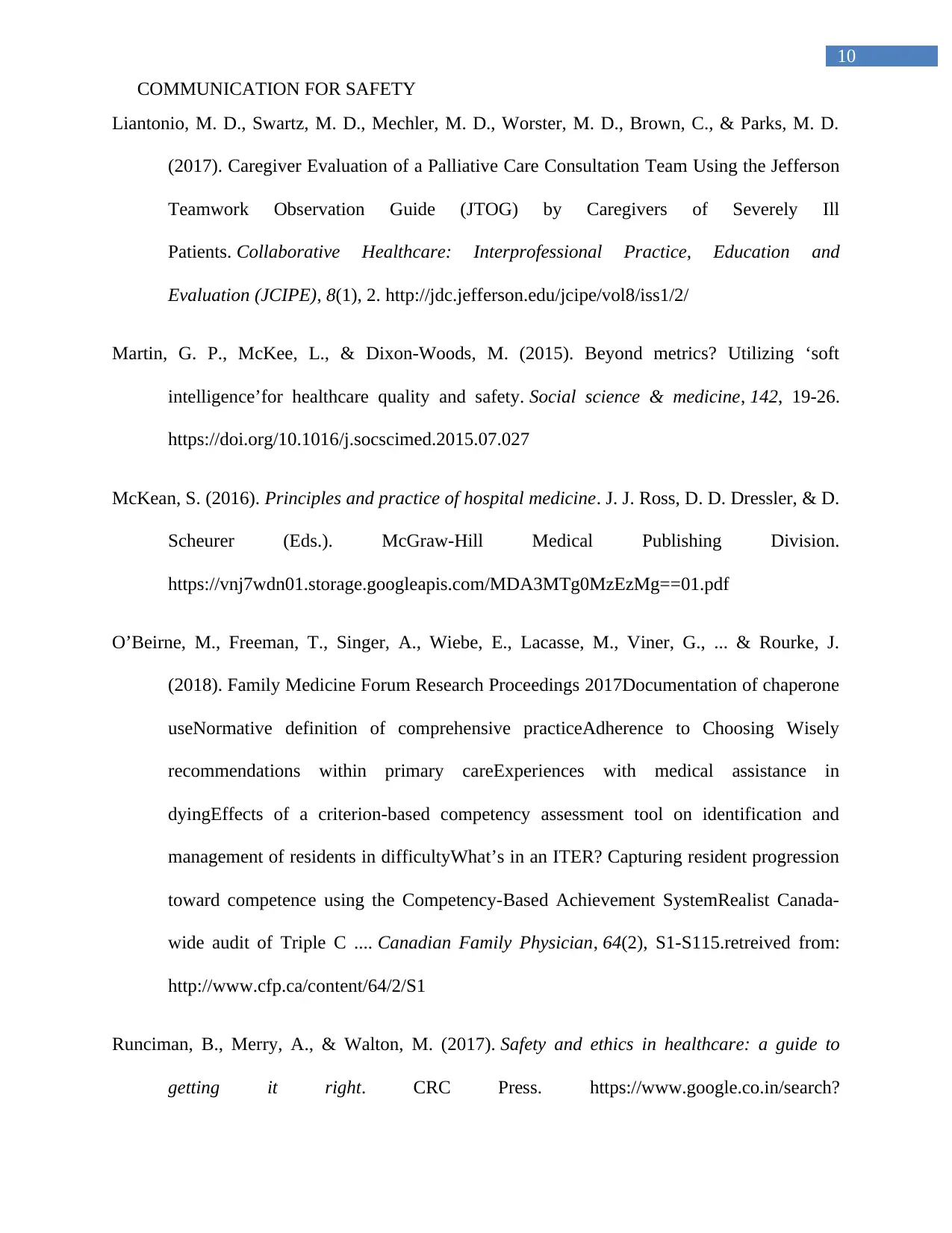
10
COMMUNICATION FOR SAFETY
Liantonio, M. D., Swartz, M. D., Mechler, M. D., Worster, M. D., Brown, C., & Parks, M. D.
(2017). Caregiver Evaluation of a Palliative Care Consultation Team Using the Jefferson
Teamwork Observation Guide (JTOG) by Caregivers of Severely Ill
Patients. Collaborative Healthcare: Interprofessional Practice, Education and
Evaluation (JCIPE), 8(1), 2. http://jdc.jefferson.edu/jcipe/vol8/iss1/2/
Martin, G. P., McKee, L., & Dixon-Woods, M. (2015). Beyond metrics? Utilizing ‘soft
intelligence’for healthcare quality and safety. Social science & medicine, 142, 19-26.
https://doi.org/10.1016/j.socscimed.2015.07.027
McKean, S. (2016). Principles and practice of hospital medicine. J. J. Ross, D. D. Dressler, & D.
Scheurer (Eds.). McGraw-Hill Medical Publishing Division.
https://vnj7wdn01.storage.googleapis.com/MDA3MTg0MzEzMg==01.pdf
O’Beirne, M., Freeman, T., Singer, A., Wiebe, E., Lacasse, M., Viner, G., ... & Rourke, J.
(2018). Family Medicine Forum Research Proceedings 2017Documentation of chaperone
useNormative definition of comprehensive practiceAdherence to Choosing Wisely
recommendations within primary careExperiences with medical assistance in
dyingEffects of a criterion-based competency assessment tool on identification and
management of residents in difficultyWhat’s in an ITER? Capturing resident progression
toward competence using the Competency-Based Achievement SystemRealist Canada-
wide audit of Triple C .... Canadian Family Physician, 64(2), S1-S115.retreived from:
http://www.cfp.ca/content/64/2/S1
Runciman, B., Merry, A., & Walton, M. (2017). Safety and ethics in healthcare: a guide to
getting it right. CRC Press. https://www.google.co.in/search?
COMMUNICATION FOR SAFETY
Liantonio, M. D., Swartz, M. D., Mechler, M. D., Worster, M. D., Brown, C., & Parks, M. D.
(2017). Caregiver Evaluation of a Palliative Care Consultation Team Using the Jefferson
Teamwork Observation Guide (JTOG) by Caregivers of Severely Ill
Patients. Collaborative Healthcare: Interprofessional Practice, Education and
Evaluation (JCIPE), 8(1), 2. http://jdc.jefferson.edu/jcipe/vol8/iss1/2/
Martin, G. P., McKee, L., & Dixon-Woods, M. (2015). Beyond metrics? Utilizing ‘soft
intelligence’for healthcare quality and safety. Social science & medicine, 142, 19-26.
https://doi.org/10.1016/j.socscimed.2015.07.027
McKean, S. (2016). Principles and practice of hospital medicine. J. J. Ross, D. D. Dressler, & D.
Scheurer (Eds.). McGraw-Hill Medical Publishing Division.
https://vnj7wdn01.storage.googleapis.com/MDA3MTg0MzEzMg==01.pdf
O’Beirne, M., Freeman, T., Singer, A., Wiebe, E., Lacasse, M., Viner, G., ... & Rourke, J.
(2018). Family Medicine Forum Research Proceedings 2017Documentation of chaperone
useNormative definition of comprehensive practiceAdherence to Choosing Wisely
recommendations within primary careExperiences with medical assistance in
dyingEffects of a criterion-based competency assessment tool on identification and
management of residents in difficultyWhat’s in an ITER? Capturing resident progression
toward competence using the Competency-Based Achievement SystemRealist Canada-
wide audit of Triple C .... Canadian Family Physician, 64(2), S1-S115.retreived from:
http://www.cfp.ca/content/64/2/S1
Runciman, B., Merry, A., & Walton, M. (2017). Safety and ethics in healthcare: a guide to
getting it right. CRC Press. https://www.google.co.in/search?
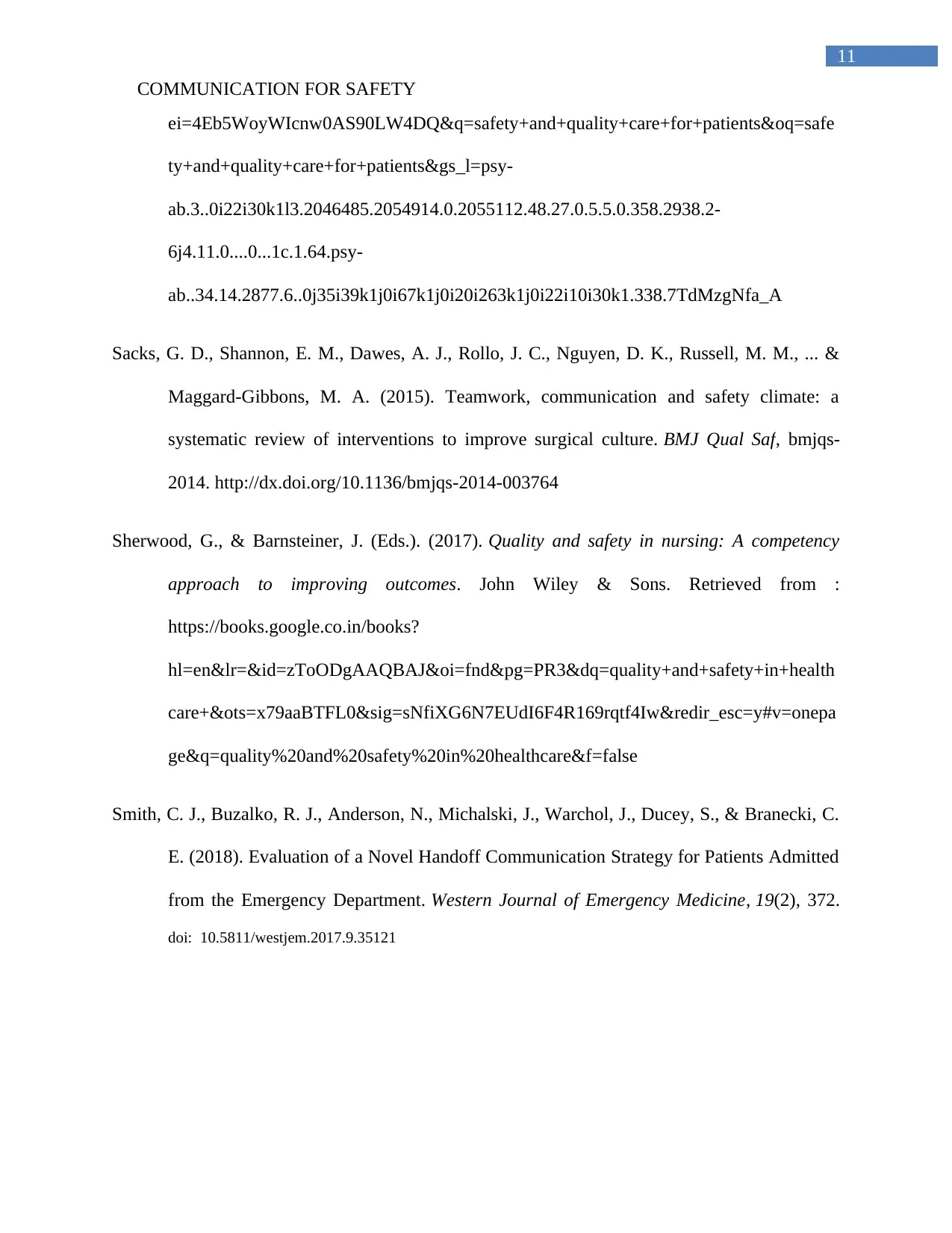
11
COMMUNICATION FOR SAFETY
ei=4Eb5WoyWIcnw0AS90LW4DQ&q=safety+and+quality+care+for+patients&oq=safe
ty+and+quality+care+for+patients&gs_l=psy-
ab.3..0i22i30k1l3.2046485.2054914.0.2055112.48.27.0.5.5.0.358.2938.2-
6j4.11.0....0...1c.1.64.psy-
ab..34.14.2877.6..0j35i39k1j0i67k1j0i20i263k1j0i22i10i30k1.338.7TdMzgNfa_A
Sacks, G. D., Shannon, E. M., Dawes, A. J., Rollo, J. C., Nguyen, D. K., Russell, M. M., ... &
Maggard-Gibbons, M. A. (2015). Teamwork, communication and safety climate: a
systematic review of interventions to improve surgical culture. BMJ Qual Saf, bmjqs-
2014. http://dx.doi.org/10.1136/bmjqs-2014-003764
Sherwood, G., & Barnsteiner, J. (Eds.). (2017). Quality and safety in nursing: A competency
approach to improving outcomes. John Wiley & Sons. Retrieved from :
https://books.google.co.in/books?
hl=en&lr=&id=zToODgAAQBAJ&oi=fnd&pg=PR3&dq=quality+and+safety+in+health
care+&ots=x79aaBTFL0&sig=sNfiXG6N7EUdI6F4R169rqtf4Iw&redir_esc=y#v=onepa
ge&q=quality%20and%20safety%20in%20healthcare&f=false
Smith, C. J., Buzalko, R. J., Anderson, N., Michalski, J., Warchol, J., Ducey, S., & Branecki, C.
E. (2018). Evaluation of a Novel Handoff Communication Strategy for Patients Admitted
from the Emergency Department. Western Journal of Emergency Medicine, 19(2), 372.
doi: 10.5811/westjem.2017.9.35121
COMMUNICATION FOR SAFETY
ei=4Eb5WoyWIcnw0AS90LW4DQ&q=safety+and+quality+care+for+patients&oq=safe
ty+and+quality+care+for+patients&gs_l=psy-
ab.3..0i22i30k1l3.2046485.2054914.0.2055112.48.27.0.5.5.0.358.2938.2-
6j4.11.0....0...1c.1.64.psy-
ab..34.14.2877.6..0j35i39k1j0i67k1j0i20i263k1j0i22i10i30k1.338.7TdMzgNfa_A
Sacks, G. D., Shannon, E. M., Dawes, A. J., Rollo, J. C., Nguyen, D. K., Russell, M. M., ... &
Maggard-Gibbons, M. A. (2015). Teamwork, communication and safety climate: a
systematic review of interventions to improve surgical culture. BMJ Qual Saf, bmjqs-
2014. http://dx.doi.org/10.1136/bmjqs-2014-003764
Sherwood, G., & Barnsteiner, J. (Eds.). (2017). Quality and safety in nursing: A competency
approach to improving outcomes. John Wiley & Sons. Retrieved from :
https://books.google.co.in/books?
hl=en&lr=&id=zToODgAAQBAJ&oi=fnd&pg=PR3&dq=quality+and+safety+in+health
care+&ots=x79aaBTFL0&sig=sNfiXG6N7EUdI6F4R169rqtf4Iw&redir_esc=y#v=onepa
ge&q=quality%20and%20safety%20in%20healthcare&f=false
Smith, C. J., Buzalko, R. J., Anderson, N., Michalski, J., Warchol, J., Ducey, S., & Branecki, C.
E. (2018). Evaluation of a Novel Handoff Communication Strategy for Patients Admitted
from the Emergency Department. Western Journal of Emergency Medicine, 19(2), 372.
doi: 10.5811/westjem.2017.9.35121
⊘ This is a preview!⊘
Do you want full access?
Subscribe today to unlock all pages.

Trusted by 1+ million students worldwide
1 out of 12
Related Documents
Your All-in-One AI-Powered Toolkit for Academic Success.
+13062052269
info@desklib.com
Available 24*7 on WhatsApp / Email
![[object Object]](/_next/static/media/star-bottom.7253800d.svg)
Unlock your academic potential
Copyright © 2020–2025 A2Z Services. All Rights Reserved. Developed and managed by ZUCOL.





